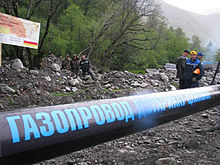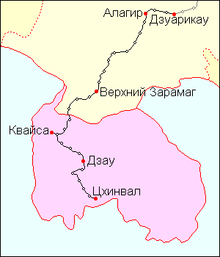Dzuarikau–Tskhinvali pipeline
| Dzuarikau–Tskhinvali pipeline | |
|---|---|
 Construction of pipeline (2008) | |
 Location of Dzuarikau–Tskhinvali pipeline | |
| Location | |
| Country | Russia, Georgia (South Ossetia) |
| General direction | north–south |
| From | Dzuarikau, North Ossetia |
| To | Tskhinvali, South Ossetia |
| General information | |
| Type | natural gas |
| Operator | Gazprom |
| Commissioned | 2009 |
| Technical information | |
| Length | 162.3 km (100.8 mi) |
| Maximum discharge | 252.5 million cubic meters per year |
The Dzuarikau–Tskhinvali pipeline (Ossetian: Газуадзæн «Дзуарыхъæу—Цхинвал») is a natural gas pipeline running from the village of Dzuarikau in North Ossetia to Tskhinvali, South Ossetia. Construction started in 2006, and gas supplies started in September 2009.[citation needed]
History
[edit]Construction of the pipeline was planned for a long time and it started in December 2006.[1] It was launched on 26 August 2009.[citation needed]
Previously, South Ossetia was supplied from the Agara-Tskhinvali leg of the Tbilisi-Kutaisi trunk system of Georgia.[citation needed] After the Georgian-Ossetian conflict, supplies to South Ossetia from Georgia were cut off. According to Georgia, the cause was a damaged section of the pipeline within South Ossetia, while Russia denied the damage and accused Georgia of the deliberate cutoff. Supplies were restored in January 2009.[citation needed]
Technical description
[edit]The length of the pipeline is 162.3 kilometres (100.8 mi) and it has capacity of 252.5 million cubic meters of natural gas per year.[2][3] The diameter of the pipeline is 426 millimetres (16.8 in). Around 70.2 kilometres (43.6 mi) of the pipeline is in South Ossetian territory.[citation needed] The pipeline passes through mountainous regions with a maximum altitude of 3,148 metres (10,328 ft) above sea level. It has been reported that the pipeline may be the located the highest in the world.[2] The cost of construction was 15 billion rubles (US$476 million).[citation needed] The pipeline is operated by Gazprom Transgaz Stavropol, a subsidiary of Gazprom. It was built by Stroyprogress.
Political significance
[edit]The pipeline was said to be important for the de facto independence of South Ossetia, because it "shakes off the last levers exerted by its unfriendly neighbour".[2] The Georgian foreign ministry protested against the launch of the pipeline.[4]
See also
[edit]References
[edit]- ^ "Construction of North-South Ossetia gas pipeline might begin soon". Russia & CIS Business and Financial Newswire. 2006-07-31. Retrieved 2009-08-30.[dead link]
- ^ a b c Artem Gorbunov (2009-04-09). "Tbilisi loses its levers over Tskhinvali". Georgia Times. Archived from the original on 2016-03-06. Retrieved 2009-08-28.
- ^ "Putin invites S Ossetia to become transit state for Russian natural gas". ITAR-TASS. 2009-08-26. Archived from the original on 2009-12-01. Retrieved 2009-08-30.
- ^ "Tbilisi States Dzuarikau-Tskhinvali gas line is infringment Georgian Sovereignty". The Georgian Times. 2009-08-27. Archived from the original on 2010-10-24. Retrieved 2009-08-30.

